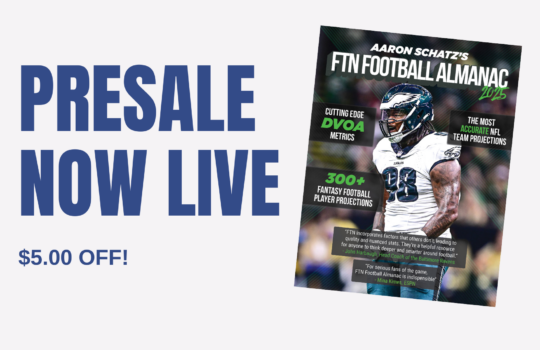
Auction leagues are one of the fastest-growing formats of fantasy football. Contrary to the typical snake draft, auction drafts are less about taking who you can when it’s your turn and more about using your resources in the best possible way. In other words, if there’s a player you want in a snake draft, you have to hope he’s available at your pick, but if there’s a player you want in an auction you can get him … if you’re willing to pay enough.
For those who haven’t dipped their toes into the auction format yet, here’s a quick rundown of the format, the strategies and the best approach.
Budget and timer
The standard budget is $200 per team. Each team will have a draft order with nominations going in that order (no snake).
Max bid is the maximum amount you have available to bid on a player. This amount takes into consideration how many roster spots you have left to fill. If you have $3 remaining with two spots left on your roster, for example, your maximum bid would be $2 due to needing a minimum of $1 per player/roster spot.
Most leagues will have a liberal timer if the auction is being done live. In that case the player and bid amount is announced. If your auction is online, there will be an electric timer for every nomination. Once the player and bid amount is nominated the timer will tick down unless another bid is placed. If so, the timer usually (depending on league) goes back to 10 seconds to allow for another bid.
What to know
There’s plenty of game theory that goes into an auction draft, considering budget allocation, roster construction and room awareness. Generating and projecting a positive or negative ROI for the player pool will give you leverage when each player is being nominated. Make sure you study our FTN auction values. Doing so will immediately give you an advantage on your competition. Auctions are a grind with each team having a battleship, and you’re given the opportunity to sink their ship by manipulating and maneuvering your way through the auction.
Budget allocation
Designing an effective budget allocation starts with breaking down how much you want to absorb at each position. Listed below is a rough estimate on optimal percentages toward each position.
League Format; QB, 2RB, 3WR, TE, FLEX, K, DST, Bench (10)
QB: 2.0% ($4)
RB: 41.5% ($83)
WR: 35.0% ($70)
TE: 5.0% ($10)
FLEX: 7.5% ($15)
K: 0.5% ($1)
DST: 0.5% ($1)
Bench: 8.0% ($16)
Don’t be tight with your money if it comes down to an extra dollar early. Pony up if the player is part of a certain tier you’re targeting. In other words, you want to get a player early in a tier rather than late. For example, T.Y. Hilton, Tyler Lockett, Deebo Samuel, Will Fuller, Tyler Boyd, Marquise Brown and Michael Gallup could all be considered in a tier (individual rankings might vary, but just for instance). Regardless of which wide receiver in this tier is the last available, that last one remaining could cost five-plus dollars more than the average price in this range due to the tier drying up. It’s an ugly scene and best for you to secure your targets if they qualify in the percentage range you’re willing to invest at the position.
Roster construction
Creating the optimal roster construction should be trouble-free in an auction if you stick to your percentages per roster spot. Creating a stable budget allocation while using FTN’s auction values will give you an edge.
- With a 40%-plus allocation toward running back, you will be able to obtain the likes of two stable backs. In the first NFFC auction this year, you could have rostered Kenyan Drake ($45) and Joe Mixon ($37) for a total of $82 (41.0%). If sticking to this allocation you can feel comfortable paying more than $45 if you want to land somebody like Saquon Barkley, which still provides enough for Melvin Gordon or James Conner. Leaving your auction with two running backs that would be going in the first three rounds on average is suggested.
- The wide receiver position is stacked this season. Mentioned above were some bid amounts in this year’s first NFFC auction. In that auction you could have used 35.0% of your budget at wide receiver to secure the likes of Odell Beckham ($24), JuJu Smith-Schuster ($23) and Calvin Ridley ($23). If you prefer to blend in a wide receiver going in the first two rounds of a snake draft you could spend up for someone like Julio Jones then spend down for a duo like D.J. Chark and Michael Gallup.
- You’ll notice that only 2.5% or so will be allocated toward a quarterback. In single-QB leagues, this will generally be the only quarterback you roster. we don’t suggest drafting two quarterbacks in fantasy football unless you’re playing in a superflex league. The quarterbacks available on the waiver wire will usually be good enough to be replacement level for a week. On top of that, if the quarterback you drafted gets injured you don’t have to sweat the loss due to investing a small amount of your draft capital at the position — you simply add a new quarterback via waiver wire or FAAB and keep on truckin’. With a 2.0% budget or less you can be the winning bidder on quarterbacks in the Drew Brees/Matthew Stafford/Daniel Jones/Baker Mayfield tier. As much fun as it sounds paying up for Kyler Murray or Dak Prescott, you’ll eventually realize at some point in the season that you desperately could have used those extra funds toward skill positions. You can win a fantasy football league with Stafford.
- Remember when the tight end position was a dumpster fire? Prime Rob Gronkowski would have cost you $40 or more due to the major gap in production Gronk provided over the rest of the tight end pool. This season we have two top-tier tight ends in Travis Kelce and George Kittle. Unfortunately, you won’t be able to afford either of them if you plan on using the budget allocation listed above. You could deduct most of your budget at flex to acquire Kelce or Kittle, but doing so would only leave you with a few dollars at the flex position. For now, let’s stick to the plan of spending around 5.0% of your budget at tight end. With that budget in mind the tight ends that should be available from $10 and below are the likes of Evan Engram, Hunter Henry and Tyler Higbee. The less you spend on tight end and quarterback, the more you can spend on running back and wide receiver. That is where you’re going to want to eat. Noah Fant, Jonnu Smith, Dallas Goedert, Blake Jarwin and Chris Herndon are a few tight ends that pop while only soaking up 2.0% or less of your budget. Leaving your auction with Jarwin and Herndon while only spending a few dollars would be smashing.
- The FLEX position is there to allow you flexibility when constructing your weekly roster. We’re still early in the draft season, but it seems to be crucial to have at least three running backs with a secure role on their team’s offense. The position dries up quickly, and once it does it isn’t pretty. You likely already know how brutal it is when trying to add a running back off the waiver wire once their role expands due to talent, skill or injury. It’s a royal rumble you don’t want to stress about being part of. As I like to say, “Being ringside is much better than being inside the ring.” You’re going to give yourself a much better chance of not stressing weekly on your running back situation if you stick to securing three. It’s up to you or our helpful crew at FTN to help you decide which player you start each week at FLEX.
- You’re going to spend one dollar each at kicker and defense/special teams. That’s it. This also means you won’t be spending an additional dollar on a second defense/special teams for your bench. These two roster spots are purely fillers. There is an art to streaming your defense/special teams that comes with zero attachment. It is vital for you to understand that while keeping a strict policy during your auction. If you spent more than 0.5% ($1) on each kicker and defense/special teams, you’ve made a mistake.
Poker mindset
You need to come to the auction with a poker mindset. Study the other team’s roster, remaining budget and max bid. Those are three key components that will help you dictate who you want to nominate, whether that be a player you want to buy or a player you dislike. If you project a player to provide a negative ROI, you might nominate them just to get an opponent’s remaining budget down. This is one of the most common nomination strategies you will see in an auction. It goes much deeper than that once rosters are being filled and budgets are decreasing. After teams start to fill out, you will notice each team having needs. If multiple teams have a need that aren’t one of yours then nominating a certain position can lead to a bidding war while you get to sit back enjoy your beverage and watch money fly off the board. The next level to that would be nominating the last player of a tier. An example of that was mentioned in the budget allocation section. If you aren’t targeting a certain tier and there is only one player left in that tier, nominating the player will have your league mates scrambling in a frenzy, reeking of desperation which makes their roster being off balance from over allocating their funds.














































 New York Jets
New York Jets  New England Patriots
New England Patriots  Miami Dolphins
Miami Dolphins  Buffalo Bills
Buffalo Bills  Pittsburgh Steelers
Pittsburgh Steelers  Cleveland Browns
Cleveland Browns  Cincinnati Bengals
Cincinnati Bengals  Baltimore Ravens
Baltimore Ravens  Tennessee Titans
Tennessee Titans  Jacksonville Jaguars
Jacksonville Jaguars  Indianapolis Colts
Indianapolis Colts  Houston Texans
Houston Texans  Las Vegas Raiders
Las Vegas Raiders  Los Angeles Chargers
Los Angeles Chargers  Kansas City Chiefs
Kansas City Chiefs  Denver Broncos
Denver Broncos  Washington Commanders
Washington Commanders  Philadelphia Eagles
Philadelphia Eagles  New York Giants
New York Giants  Dallas Cowboys
Dallas Cowboys  Minnesota Vikings
Minnesota Vikings  Green Bay Packers
Green Bay Packers  Detroit Lions
Detroit Lions  Chicago Bears
Chicago Bears  Tampa Bay Buccaneers
Tampa Bay Buccaneers  New Orleans Saints
New Orleans Saints  Carolina Panthers
Carolina Panthers  Atlanta Falcons
Atlanta Falcons  San Francisco 49ers
San Francisco 49ers  Seattle Seahawks
Seattle Seahawks  Los Angeles Rams
Los Angeles Rams  Arizona Cardinals
Arizona Cardinals 





 Boston Celtics
Boston Celtics  Brooklyn Nets
Brooklyn Nets  Philadelphia 76ers
Philadelphia 76ers  New York Knicks
New York Knicks  Toronto Raptors
Toronto Raptors  Chicago Bulls
Chicago Bulls  Detroit Pistons
Detroit Pistons  Milwaukee Bucks
Milwaukee Bucks  Cleveland Cavaliers
Cleveland Cavaliers  Indiana Pacers
Indiana Pacers  Orlando Magic
Orlando Magic  Atlanta Hawks
Atlanta Hawks  Charlotte Hornets
Charlotte Hornets  Miami Heat
Miami Heat  Washington Wizards
Washington Wizards  Denver Nuggets
Denver Nuggets  Minnesota Timberwolves
Minnesota Timberwolves  Oklahoma City Thunder
Oklahoma City Thunder  Portland Trail Blazers
Portland Trail Blazers  Utah Jazz
Utah Jazz  LA Clippers
LA Clippers  Golden State Warriors
Golden State Warriors  Los Angeles Lakers
Los Angeles Lakers  Phoenix Suns
Phoenix Suns  Sacramento Kings
Sacramento Kings  Dallas Mavericks
Dallas Mavericks  Houston Rockets
Houston Rockets  Memphis Grizzlies
Memphis Grizzlies  New Orleans Pelicans
New Orleans Pelicans  San Antonio Spurs
San Antonio Spurs 











